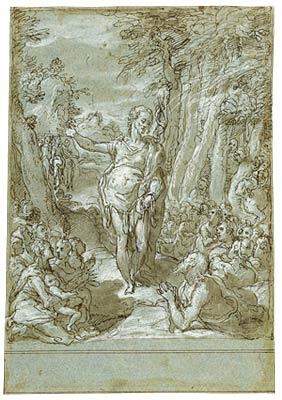 The last third of the sixteenth century saw the predominance of a highly decorative and technically masterful style generally known as Late Mannerism. This is exceptionally well represented in the Morgan collection, with outstanding examples by Taddeo and Federico Zuccaro and their followers Girolamo Muziano, Jacopo Bertoia, and Cesare Nebbia. The weightless grace of their style can be seen in Taddeo's St. John the Baptist Preaching and The Foundation of Orbetello, the latter a study for decoration of the Palazzo Farnese. Among the myriad themes that define the period is the need of the Roman Catholic Church to defend its authority against the rising threat of Protestantism. The Renaissance popes' lavish spending had led them to encourage the sale of indulgences—two are documented in the exhibition—a practice heavily criticized by Martin Luther. Eventually, the Catholic Church recognized the need for reforms and convened the Council of Trent, resulting in a movement known as the Counter-Reformation, the consequences of which became apparent in artistic production toward the end of the sixteenth century. Palestrina's mass for Pope Marcellus, the published score and recording of which are featured in the exhibition, places counter-reformatory emphasis on an easily comprehensible declamatory text.
The last third of the sixteenth century saw the predominance of a highly decorative and technically masterful style generally known as Late Mannerism. This is exceptionally well represented in the Morgan collection, with outstanding examples by Taddeo and Federico Zuccaro and their followers Girolamo Muziano, Jacopo Bertoia, and Cesare Nebbia. The weightless grace of their style can be seen in Taddeo's St. John the Baptist Preaching and The Foundation of Orbetello, the latter a study for decoration of the Palazzo Farnese. Among the myriad themes that define the period is the need of the Roman Catholic Church to defend its authority against the rising threat of Protestantism. The Renaissance popes' lavish spending had led them to encourage the sale of indulgences—two are documented in the exhibition—a practice heavily criticized by Martin Luther. Eventually, the Catholic Church recognized the need for reforms and convened the Council of Trent, resulting in a movement known as the Counter-Reformation, the consequences of which became apparent in artistic production toward the end of the sixteenth century. Palestrina's mass for Pope Marcellus, the published score and recording of which are featured in the exhibition, places counter-reformatory emphasis on an easily comprehensible declamatory text.
Taddeo Zuccaro (Sant'Angelo in Vado 1529–1566 Rome)
St. John the Baptist Preaching
Pen and brown ink, brown wash, heightened with white gouache, on blue paper; on a mount made by Giorgio Vasari
Gift of Janos Scholz, 1973; 1973.26
